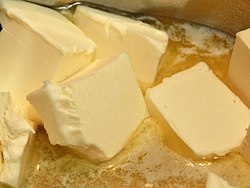This article needs additional citations for verification .(July 2025) |

A French butter dish is a cylindrical container used to maintain the freshness and spreadable consistency of butter without refrigeration. Butter is kept in what appears to be the lid, inverted, and submerged in water held in the base. [1]
Contents
This late 19th-century French-designed pottery crock has two parts: a base that holds water, and a cup to hold the packed butter which also serves as a lid. The cup containing butter is placed into the base, where water creates an airtight seal that keeps the air (and thus oxygen) away from the butter so that refrigeration is not needed, and the butter can be used in its soft form. This method will keep butter for around a month provided it is kept at temperatures below 80 °F (27 °C) and the water is changed regularly.[ citation needed ]
